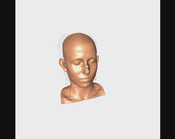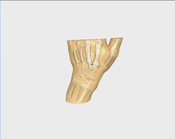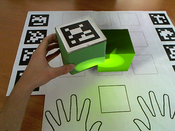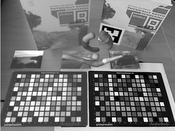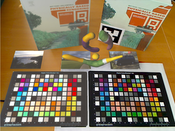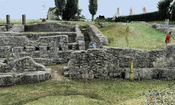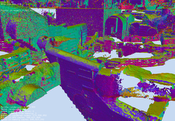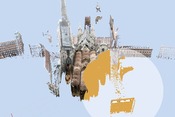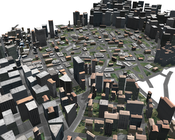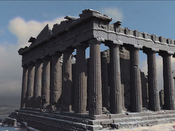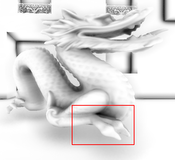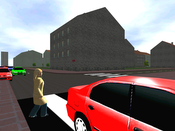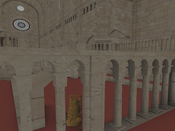Show images of current Projects | Years: 2010 - 2011 - 2012.
X-Mas Cards
Every year a christmas card showing aspects of our research projects is produced and sent out.ViMaL: A Visualization Mapping Language
Visualization is the discipline dealing with the depiction of data. The assignment of visual abstractions to data abstractions is referred to as the visualization mapping.Expressive visualization mappings proofed in many cases to be more effective than the examination of raw data (i.e., large tables of numbers). Although visualization mapping is a crucial step in the visualization pipeline surprisingly few general approaches exist.
We propose to develop the Visualization Mapping Language (ViMaL) that is capable of describing expressive visualization mappings and provides user interfaces suitable for non-experts in visualization.
ViMaL will be a language that is used to specify visualization pipelines. We will provide language concepts for the specification of data abstraction processes, visual concretization processes and the required visualization mapping. With this approach the semantics of a specific domain are modeled by the domain experts while the semantics of the visualization domain are modeled by the visualization expert. The visualization mapping is described using domain semantics as well as visualization semantics. Unlike other general purpose visualization systems, ViMaL systems explicitly use the semantics of the visualization mapping process. It incorporates information and knowledge assisted methods in the visualization mapping pipeline.
In the scope of this project we will define a novel Visualization Mapping Language and implement a toolbox that aids researchers from other areas to integrate the ViMaL concepts into their systems. The toolbox will provide basic ViMaL document setup and parsing as well as components for each step in the visualization pipeline. We will make use of fuzzy logic in our components for the abstraction of data, for the visual concretization, and for the visualization mapping.
We believe that the formalization of the visualization pipeline that is achieved with the visualization mapping language will enable many researchers from other domains to benefit from existing visualization methods. Further, the introduction of domain and visualization semantics for the specification of visualization mappings enables meta-visualization approaches that provide insight into the visualization process itself. Laypersons will benefit from such meta-visualization systems that are able to illustrate the involved components.
Reciprocal Shading for Mixed Reality
The aim of this project is to simulate the mutual influence between real and virtual objects in mixed reality applications.Detailed Surfaces for Interactive Rendering
In this project we study new representation and rendering methods for surface detail in real time.TERAPOINTS - High Quality Visualization and Interaction with Gigantic Point Data Sets
Laser scanning is an important tool in cultural heritage for documenting the state of archaeological monuments. The data produced by laser scanning is ever increasing, with the latest generation of laser scanners generating a billion of points in one measurement pass. To colorize the laser scans, additional photographs are taken. Managing these huge amounts of data in terms of size is a challenge on its own, but also to ensure the quality of the resulting point-based models is of utmost importance for the further development of laser scanning as a standard technique in cultural heritage. We identified three topics that can drive forward the integration of laser scanning in the everyday work of archaeologists.GAMEWORLD - Procedural Worlds for Games
The aim of the GAMEWORLD project is to procedurally generate cities, villages and other game environments mainly to be used in tomorrow's video games.General Purpose Visibility
Visibility culling is a fundamental problem of computer graphics, and is of crucial importance for many applications, like game development or architectural design. For example, interactively rendering a model containing hundreds of millions of polygons like the Boeing 777 model shown on the cover page is only possible when invisible parts of the model are "culled" away. Solving the visibility problem has been an important research topic for many years, and countless methods have been proposed. Amazingly, most approaches still have more or less serious issues that prevent their widespread use. Preprocessed visibility solutions attempt to solve the problem in an offline step, but are often slow, lack robustness, and are hard to implement. Online culling algorithms have a lot of potential since they can be used on arbitrary scenes, but they induce an overhead during rendering which is unacceptable for applications that strive for optimal performance. We believe that basic research problems remain unsolved until this day for preprocessed visibility as well as for online culling, and the goal of this project is to tackle and solve the majority of these problems. In order to do this, we have to gain more insight into the complex properties of visibility, which are still not entirely understood. Our proposed methods have applications in various fields, like game development, architectural design, urban visualization, or massive model visualization.



